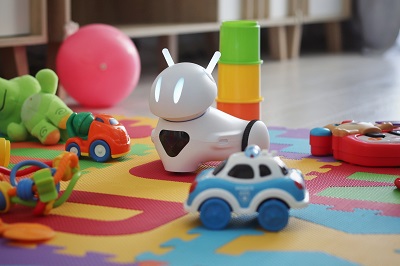Educational toys are expected to promote intellectual, emotional and physical development of a child. Today’s stringent regulations for children’s toys are pushing manufacturers to innovate and create toys that can comply with standards in terms of safety.
In this area, material solutions providers are making a big leap. KRAIBURG TPE recently showed off its capability to supply thermoplastic elastomers (TPEs) for several functional components of the Photon, an innovative educational robot. The Photon educational robot, launched by Photon Entertainment Sp. z o. o. based in Białystok (Poland), is a teaching robot that helps children expand their logical skills while they play.
Two established THERMOLAST® K compounds from KRAIBURG TPE are being used for the running surfaces as well as the feelers and eyes of the interactive robot. These compounds include a highly transparent product from the FC/ht series that complies with the DIN EN 71-3 toy standard.
Photon is steered using a centrally placed castor and it moves on two laterally mounted rear wheels, the running surfaces of which are made of a GP/FG THERMOLAST K compound. Two transparent feelers at its head serve as antennas and light sensors, respectively. To provide “emotional” feedback, the robot has two eyes that can change colour, as do the feelers. The feelers and eyes are made of FC/ht THERMOLAST K compound.
“We wanted the children to experience the robot not primarily as a technical toy, but rather as an interactive companion that promotes logical thinking and helps them explore the world of robotisation and digitalisation while they play,” says Michał Grześ, co-founder of Photon Entertainment. “It goes without saying that we paid attention to compliance with the strictest standards during the development process, including EN 71-3, which regulates the migration behavior and physiological harmlessness of toy materials and their flame-resistance.”
It‘s no accident that the educational robot was invented in the college town of Białystok in eastern Poland. The local technical college has been regarded as a “think tank” for innovative robotics worldwide since 2014, when the University Rover Challenge was held in the USA. That was already the third time that a team from Białystok had won the challenge – with the Hyperion 2 Mars robot, construction of which was directed by Michał Grześ.

Białystok is also the base for Experteam Sp. z o. o., which specialises in innovative plastics applications and is supplying injection mouldings for the Photon. “The robot’s running surfaces, feelers and eyes are basic functional parts and interactive components, and we were looking for materials for them that would provide both a pleasant touch and the necessary durable robustness for everyday use,” explains Paweł Matczuk, New Project Introduction Manager at Experteam. “These applications were the first project that we’ve implemented together with KRAIBURG TPE. The materials manufacturer provided us with excellent support, starting from selecting suitable thermoplastic elastomers to colour-matching the components on site – enabling us to meet the ambitious schedule for launching the robot.”
For Photon’s feelers and eyes, Experteam chose an FC/ht (Food Contact, highly transparent) compound from the THERMOLAST K series that has already been tried and tested many times in different end products that come into contact with food and skin. The applications include household items, packaging, razors, toothbrushes and last but not least toys. In addition to satisfying the criteria set by the FDA (CFR 21) and EU Regulation No. 10/2011 for applications with food contact, the compound also meets the strict requirements of DIN EN 71-3 for the safety of toys, which limits the use of ingredients containing heavy metals.
The selected TPE compound also provides superior flowability and nonslip soft-touch characteristics, combined with a hardness of 80 Shore A. Its excellent transparency supports interaction with the robot, as its feelers and eyes are also designed as communicative light elements that change color depending on the task or “reaction” and require good light scattering.
A black THERMOLAST K compound from the GP/FG (General Purpose, Low Fogging) series is used for the Photon’s running surfaces. The compound’s 60 Shore A abrasion resistance ensures that the robot does not leave any marks on sensitive floors. This TPE also provides good flowability and pleasant touch characteristics. In addition, it is UL94 HB-listed. Typical applications are functional elements such as handles, thumbwheels, push buttons, switches, seals and gaskets.
The design of the Photon educational robot is based on its functions being activated step by step – moving towards targets, identifying obstacles, noticing touch contacts, and reacting to light, sounds and language. This means the children can learn about programming while they play. Photon Entertainment also offers the robot as a package with various teaching apps for schools and kindergartens. “We are pleased that we were able to help make this remarkable educational toy a success,” says Michael Pollmann, Director of Sales and Marketing EMEA at KRAIBURG TPE.














